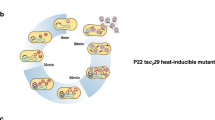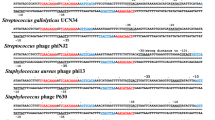Abstract
THE 3,000 base pair-long G segment of temperate coliphage Mu DNA has been shown to invert spontaneously with high frequency1,2. Inversion, which is independent of the rec system of the host3, results in Mu phage with the G segment in either orientation. Nearly equal numbers of both G orientations are observed in a lysogen or when a lysate is obtained by induction of a lysogen. When phage is grown by a series of infections one and the same G orientation prevails4. One attractive explanation for these observations implicates inversion of the G segment in the control of phage or host functions. We report here experiments which show that the orientation of the G segment determines infectivity of Mu phage particles and that G inversion is mediated by a phage-specific enzyme system.
This is a preview of subscription content, access via your institution
Access options
Subscribe to this journal
Receive 51 print issues and online access
$199.00 per year
only $3.90 per issue
Buy this article
- Purchase on Springer Link
- Instant access to full article PDF
Prices may be subject to local taxes which are calculated during checkout
Similar content being viewed by others
References
Hsu, M-T. & Davidson, N. Virology 58, 229–239 (1974).
Hsu, M-T. & Davidson, N. Proc. natn. Acad. Sci. U.S.A. 69, 2823–2827 (1972).
Daniell, E., Boram, W. & Abelson, J. Proc. natn. Acad. Sci. U.S.A 70, 2153–2156 (1973).
Daniell, E., Abelson, J., Kim, J. S. & Davidson, N. Virology 51, 237–239 (1973).
Chow, L. T., Kahmann, R. & Kamp, D. J. molec. Biol. 113, 591–609 (1977).
Howe, M. & Bade, E. Science 190, 624–632 (1975).
Allet, B. & Bukhari, A. I. J. molec. Biol. 92, 529–540 (1975).
Toussaint, A. Virology 70, 17–27 (1976).
Zieg, J., Silverman, M., Hilmen, M. & Simon, M. Science 196, 170–172 (1977).
McClintock, B. Am. Natur. 95, 265–277 (1961).
Kleinschmidt, A. Meth. Enzym. 12 B, 361–377 (1968).
Westmoreland, B. C., Szybalski, W. & Ris, H. Science 163, 1343–1348 (1969).
Davis, R. W., Simon, M. N. & Davidson, N. Meth. Enzym. 21 D, 413–428 (1971).
Bukhari, A. I. & Curtin, P. J. Virol. 14, 1516–1616 (1974).
Kahmann, R., Kamp, D. & Zipser, D. Molec. gen. Genet. 149, 323–328 (1976).
Sugden, B., DeTroy, B., Roberts, R. J. & Sambrook, J. Analyt. Biochem. 68, 36–46 (1975).
Kahmann, R., Kamp, D. & Zipser, D. in DNA Insertion Elements, Plasmids and Episomes (eds Bukhari, A. I., Shapiro, J. A. & Adhya, S. L.) 335–340 (Cold Spring Harbor Laboratory, Cold Spring Harbor, 1977).
Miller, J. H. Experiments in Molecular Genetics (Cold Spring Harbor Laboratory, Cold Spring Harbor, 1972).
Kamp, D. & Meissner, H. Molec. gen. Genet. (submitted).
Author information
Authors and Affiliations
Rights and permissions
About this article
Cite this article
KAMP, D., KAHMANN, R., ZIPSER, D. et al. Inversion of the G DNA segment of phage Mu controls phage infectivity. Nature 271, 577–580 (1978). https://doi.org/10.1038/271577a0
Received:
Accepted:
Published:
Issue Date:
DOI: https://doi.org/10.1038/271577a0
This article is cited by
-
Role of phage ϕ1 in two strains of Salmonella Rissen, sensitive and resistant to phage ϕ1
BMC Microbiology (2018)
-
Nucleotide sequence of diatom plasmids: identification of open reading frames with similarity to site-specific recombinases
Plant Molecular Biology (1992)
-
Spatial relationship of the Fis binding sites for Hin recombinational enhancer activity
Nature (1987)
-
Transcription initiation of Mu mom depends on methylation of the promoter region and a phage-coded transactivator
Nature (1983)
-
Transposable elements of maize
Molecular and General Genetics MGG (1983)
Comments
By submitting a comment you agree to abide by our Terms and Community Guidelines. If you find something abusive or that does not comply with our terms or guidelines please flag it as inappropriate.



